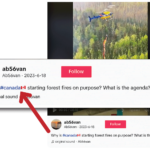
It’s June 2023 and Canada is on fire. Ongoing wildfires spread across the country, engulfing various regions in flame and smoke. With Fatima Syed, Drew Anderson cowrites “It Isn’t Arson: Untangling Climate Misinformation Around Canada’s Raging Wildfires” for The Narwhal.
Anderson describes Alberta’s most recent provincial election as apocalyptic. There was an orange glow behind politicians as they stood on stage speaking about climate change while ignoring the cause of the blaze around them, claiming arson. In Alberta, where firefighter services were being cut by the government, Syed and Anderson write, “It wasn’t balaclava-clad arsonists; it was really truly budget cuts and climate change” starting fires.
Climate misinformation pertains to unintentionally inaccurate or misleading content, whereas climate disinformation refers to the spread of intentionally deceptive information, both of which undermine the existence of climate change and climate action.
Marc Fawcett-Atkinson, a journalist at Canada’s National Observer who covers topics such as climate and the environment, says there are two ways disinformation is spread. One is a more strategic approach, often led by fossil fuel companies, which typically leads to things like greenwashing. The other is from what Fawcett-Atkinson describes as “conspiracy theorists,” who, explicitly or not, are usually repeating messages from the fossil fuel industry online. “That one is much more organic,” says Fawcett-Atkinson. “People see something that resonates with them and they share it.” A 2021 report from U.K.-based Stop Funding Heat found that there are between 818,000 and 1.36 million views of climate misinformation posts on Facebook every day.
But the more concerning long-term danger of disinformation is that “it erodes the ability for countries to essentially implement climate policies and reduce carbon emissions,” says Fawcett-Atkinson. He emphasizes that the way in which climate disinformation is framed has changed from a focus on total climate denial to undermining efforts to counteract climate change.
When reporting on climate change and climate disinformation, journalists have two main concerns, says Fawcett-Atkinson: fact-checking and believability. He says that thinking critically and checking your facts is simple practice, but getting people to believe what you’re reporting is the real struggle. “You can be as accurate as you want and as compelling as you want, as well written, as eloquent as you want and you’re still going to have conspiracy theorists that say what you’re doing is totally false.”
To avoid falling for climate misinformation, consumers must, first of all, authenticate everything they see. The Natural Resources Defense Council states that audiences can limit the spread of misinformation by debunking content with facts, pausing before sharing content to verify where the information is coming from, and reporting all climate misinformation found on social media.
It’s essential for journalists to continue covering climate disinformation in order to push people into having productive discussions about climate change. “We are at a time in human history,” says Anderson, “where pretty drastic, pretty expensive, pretty far-reaching action needs to be taken.”





